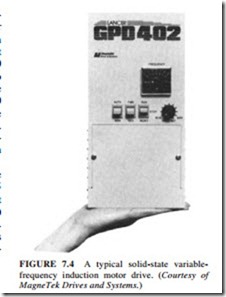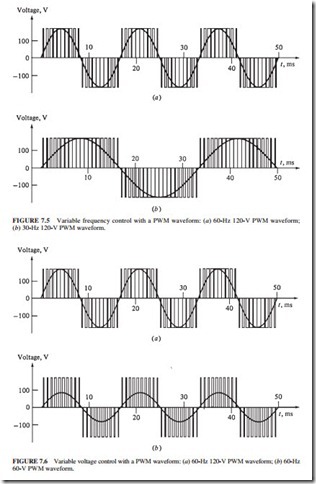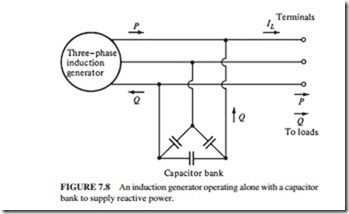MOTOR PROTECTION
The induction motor drive has a variety of features for protecting the motor. The drive can detect and trip the motor under any of the following conditions:
1. An overload (excessive steady-state currents)
2. Excessive instantaneous currents
3. Overvoltage
4. Undervoltage
THE INDUCTION GENERATOR
Figure 7.7 illustrates the torque-speed characteristic of an induction machine. It shows clearly that if an induction motor is driven at a speed higher than the synchronous speed by
a prime mover, the direction of the induced torque will reverse and it will act as a generator. As the torque applied to the shaft increases, the power generated increases. However, there is a maximum possible induced torque in the generator region of operation (pushover torque). If the actual torque is higher than the pushover torque, the machine will overspeed.
An induction machine operating as a generator has severe limitations. An induction generator cannot produce reactive power because it does not have a separate field circuit. In reality, it requires reactive power. An external source of reactive power must be provided to it at all times to maintain its stator magnetic field. The induction generator cannot con- trol its own output voltage because it does not have a field circuit. The terminal voltage of the generator must be maintained by the external power system which is connected to it.
The main advantages of the induction generator are its simplicity and its ability to operate at different speeds (higher than synchronous speed). Since no sophisticated regulation is required, this generator is suitable for windmills and supplementary power sources connected to an existing power system. In these applications, the power factor correction can be provided by capacitors, and the terminal voltage can be controlled by an existing power system (the grid).
Induction Generator Operating Alone
The induction generator can operate independently of any power system, if capacitors are available to supply the reactive power required by the generator and by the load. This arrangement is shown in Fig. 7.8.
The magnetization current required by the induction machine as a function of the terminal voltage can be found by running the machine as a motor at no load and measuring its armature current. This magnetization curve is shown in Fig. 7.9a. Therefore, the induction generator can achieve a given voltage level if the external capacitors are supplying the magnetization current corresponding to that level. The reactive current produced by a capacitor is directly proportional to the voltage applied to it (straight-line relationship). Figure 7.9b illustrates the variation of voltage with current for a given frequency.
The induction generator must be flashed by momentarily running it as a motor. This is done to establish residual flux in the rotor, which is needed to start the induction generator. When the induction generator is starting, a small voltage is produced by the residual mag- netism in its field circuit. A capacitive current flow is produced by the small voltage which increases the terminal voltage. The increase in terminal voltage increases the capacitive current, which increases the terminal voltage further until the voltage is fully built up.
The main disadvantage of induction generators is that their voltage varies significantly with changes in load (especially reactive load). Figure 7.10 illustrates a typical terminal voltage-current characteristic of an induction generator operating alone with a constant parallel capacitance.
The voltage collapses very rapidly when the generator is supplying inductive loads because the capacitors must supply all the reactive power needed by the load and the generator. Any reactive power diverted to the load moves the generator back along its magnetization curve. This results in a major drop in generator voltage.
A set of series capacitors is included in the power line in addition to the parallel capacitors. The capacitive reactive power increases with increasing load. This compensates for the reactive power demanded by the load.
Figure 7.11 illustrates the terminal characteristic of an induction generator with series capacitors. The frequency of the induction generator varies slightly with the load. However, this frequency variation is limited to less than 5 percent because the torque-speed characteristic is very steep in the normal operating range. This variation is acceptable in many applications such as isolated or emergency generators. The induction generator is ideal for windmills and energy recovery applications. Since most of these applications operate in parallel with the grid, the terminal voltage and frequency are controlled by the grid. Capacitors are used for power factor correction.



